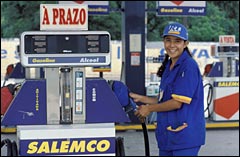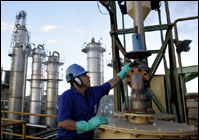In 2006, Brazil officially achieved “energy independence” — that is, its oil exports came into line with imports and cancelled them out. No longer beholden to foreign suppliers for its energy needs, the nation theoretically has no stake in costly Middle East military adventures to secure access to oil reserves.

Grain alcohol? Haven’t touched the stuff since college.
Photo: Whitehouse.gov
Sounds like a certain colossus to the north has a lot to learn from Brazil’s recent energy strategy, huh? Indeed, much of Brazil’s energy independence stems from a successful ethanol program, which has replaced about 40 percent of gasoline use in the country. Might the United States, with its own aggressive ethanol push, attain similar success?
Apples and Oranges, Corn and Sugarcane
Not so fast. The lessons of Brazil are not as clear-cut as they seem at first glance.
Montana chemical engineer Robert Rapier, who runs the widely read “R-Squared Energy Blog,” has succinctly laid out the fundamental differences in the U.S. and Brazilian energy landscapes — differences that significantly limit the applicability of the Brazilian model to the U.S. situation.
First of all, the United States (population 300 million) has 62 percent more people than Brazil (population 185 million) — making any move toward energy independence that much trickier.
Second, not only are there more people in the U.S., but each one of them burns through much, much more oil. Americans burn through 27 barrels of oil annually per capita, six times and change more than the Brazilians’ 4.2 barrels. The U.S. produces more oil per capita, too — 11 barrels to Brazil’s 3.35 barrels. And the gap between production and consumption in the U.S. is a gaping 16 barrels per person per year, while Brazil’s gap amounts to just 0.85 barrels.
So to provide a serious challenge to crude oil, the U.S. ethanol industry has a much steeper mountain to climb than Brazil’s. Moreover, its ethanol industry must grapple with a much heavier burden than Brazil’s as it makes that climb. Corn ethanol is thought to have a net energy balance of just 1.3 — meaning that every gallon of it produced yields just a third of a gallon of net energy. Rapier points to a study [PDF] that claims that the energy balance of ethanol made from sugarcane — Brazil’s feedstock of choice — lies somewhere between 8.3 and 10.2.
In other words, as an ethanol feedstock, sugarcane is more efficient than corn by a factor of nearly 8. And even if switchgrass-based cellulosic ethanol becomes a reality soon, the U.S. will still lag behind Brazil in this department. Lester Brown of the Earth Policy Institute reckons that switchgrass-based ethanol has a net energy balance of 4, or about half of its cane-based counterpart. “For net energy yield, ethanol from sugarcane in Brazil is in a class all by itself,” Brown concludes.
Even if the U.S. could rig up an ethanol industry as efficient as Brazil’s, its much more ravenous appetite for energy consumption would still greatly limit ethanol’s contribution to real energy independence. Consider this comparison: Brazil produces about 4.8 billion gallons of ethanol per year and by doing so, displaces 40 percent of petroleum gasoline consumption. The U.S. is expected to produce 4.8 billion gallons of ethanol in 2006 — and that will displace about 3 percent of gasoline use.
None of this implies that the U.S. should abandon research on cellulosic ethanol, or throw its hands up and keep burning a quarter of the world’s oil with just 5 percent of global population. The real lesson from Brazil is that for homegrown alternative energy to make a dent in petroleum consumption, consumption of petroleum needs to be greatly reduced. As Rapier puts it, “the reason [Brazil] achieved energy independence is primarily because of their frugal energy usage, not because of ethanol.”
Or, as über-biofuel-skeptic David Pimentel recently told Grist, “We’re using too goddamned much fossil energy.”
How They Did It
It may not be easily replicable, but Brazil’s biofuel program is the envy of the world. Critics of the present U.S. biofuel push, which draws billions in government subsidies, should take note: Brazil didn’t replace 40 percent of its gasoline use with ethanol by letting the market sort things out.
Indeed, the program is the result of a concerted, and sometimes rocky, 30-year government effort to promote the alternative fuel.
Following the oil shocks of the early 1970s, the government of Brazil adopted an ambitious plan to guarantee the country’s energy independence. The ProAlcool policy required that passenger cars be built to run on ethanol and led to installation of a nationwide distribution network, which would supply ethanol in all service stations. Supply was guaranteed via strict controls on planting of sugarcane and production of both sugar and ethanol.
By the mid-1990s, the program was abandoned as ethanol shortages and low gasoline prices led to widespread popular rejection of ethanol-powered cars. Government controls on sugarcane planting, as well as sugar and ethanol production and marketing, were also abandoned. Nonetheless, the ProAlcool program left a long-term legacy of a dedicated ethanol-handling infrastructure, an ethanol-powered automotive fleet (although the share of the fleet powered by ethanol fell steadily during the following decade), and continued production of both gasoline- and ethanol-fueled automobiles.

Ethanol at the ready.
Photo: Ron Giling/Peter Arnold, Inc.
The current resurgence of ethanol in the fuels matrix is due to a private-sector commitment to take advantage of ethanol’s availability. The flex-fuel car was developed and put into production so that consumers would be able to freely choose between gasoline and ethanol. Following the launch of flex cars in 2003, sales rocketed to more than 70 percent of new car sales by the end of 2005. The vehicles have proved a boon to automotive manufacturers, as companies that previously produced two models of each car (one for gas, another for ethanol) have been able to consolidate production lines. For consumers, flex cars mean flexibility at the pump and increased resale value.
According to the National Petroleum Agency, in 2005, Brazilian drivers purchased 10.5 billion liters (four liters equals roughly one gallon) of ethanol, 17.6 billion liters of gasoline, and 39 billion liters of diesel. Industry sources consider these figures inaccurate for ethanol due to significant clandestine sales intended to circumvent taxation. While market forces drive current demand growth for ethanol, government policy does have a significant influence on market dynamics. Policy supports for ethanol consumption include both an ethanol-use mandate and significant tax credits.
Brazil’s first ethanol-use mandate in 1977 required a 4.5 percent mixture of ethanol to gas. Since that time, the mix of ethanol in gasoline has risen as high as 25 percent. Current legislation requires an ethanol content of between 20 and 25 percent, with the executive branch having the flexibility to adjust levels within that band. The mixture stood at 25 percent from 2003 until March 2006, when ethanol shortages and rising prices prompted the government to reduce the rate to 20 percent. Mandated mixing of ethanol accounted for just over one-half of consumption in 2005.

A distillery worker in the state of Parana.
Photo: usinfo.state.gov
With the initiation of the 2006 sugar harvest, the supply situation has eased and prices have fallen, but the ethanol mandate is expected to remain at 20 percent. The increasing number of flex-fuel cars guarantees a ready market for ethanol, obviating the need to support the industry via mandated use. Indeed, some industry participants expect that current legislation will eventually be changed to reduce the ethanol mandate still further.
Since the introduction of flex cars, tax incentives play an especially important role in supporting ethanol consumption. Since ethanol delivers about a third less energy than gas per gallon, ethanol is a better buy than gas when it’s priced at 70 percent or less than the price of gas. Therefore, in theory, all flex-car owners will opt for gasoline if the price of ethanol rises above 70 percent of the gasoline price, and all flex owners will buy ethanol at a lower price. In the first quarter of 2006, increases in ethanol prices above that 70 percent level did lead to a significant decline in ethanol consumption. With flex-fuel cars approaching 10 percent of the automotive fleet and growing rapidly, and with sugarcane production growing more slowly, it is likely that ethanol demand will be rationed for years to come via seasonal and/or regional price changes. Given the sensitivity of ethanol demand in relation to price increases, tax breaks for ethanol consumption provide a significant support to ethanol producers and distributors.
The government also provides preferential treatment for ethanol consumption under federal tax programs. The differential in these assessments was estimated by industry contacts at approximately $0.51 per gallon in October 2005. And state tax regimes give ethanol consumption an even greater boost.
It’s famously said that you can’t make an omelet without breaking a few eggs. Likewise, in an energy market dominated by petroleum, it seems nearly impossible to jumpstart a viable biofuel market without government support. The trick, the Brazil lesson seems to show, is that nations should operate from a realistic assessment of their resource assets, and proceed accordingly.


